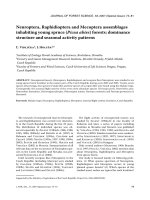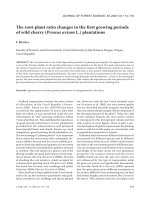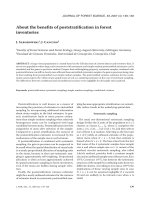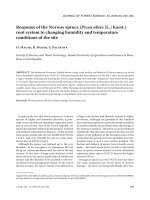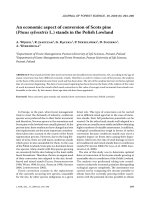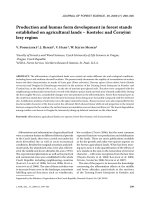Báo cáo lâm nghiệp: "Polyamines during somatic embryo development in Norway spruce (Picea abies [L.])" potx
Bạn đang xem bản rút gọn của tài liệu. Xem và tải ngay bản đầy đủ của tài liệu tại đây (226.43 KB, 6 trang )
J. FOR. SCI., 55, 2009 (2): 75–80 75
JOURNAL OF FOREST SCIENCE, 55, 2009 (2): 75–80
Somatic embryogenesis is considered as an ad-
vantageous technique for in vitro propagation of
conifers. Moreover, it could be usefully utilized for
a detailed study of developmental processes accom-
panying differentiation of embryo and its conversion
during polyembryogenesis.
Regeneration of complete plants by means of so-
matic embryogenesis in the Norway spruce (Picea
abies [L.] Karst.) was described by many authors
(B 1985; H et al. 1985; A,
F 1993; C 1985; C et al. 1990;
M et al. 1995). e process of somatic embryo-
genesis is divided into three stages according to
the grade of embryo differentiation: induction of
embryogenesis, proliferation and maturation of so-
matic embryos, and conversion of mature embryos
into complete plants. However, embryo maturation
and low germination frequencies are main limita-
tions for a broader use of this technique (A,
F 1993).
The induction of embryogenic tissues can be
achieved by applying phytohormone treatments
on mature or immature zygotic embryos. Induc-
tion and continuous proliferation require auxin and
cytokinins (CKs), whereas the further development
and maturation of embryos depend on abscisic acid
(ABA) (A et al. 1991). e initiation rate is
higher when immature zygotic embryos are used;
Supported by the Ministry of Agriculture of the Czech Republic, Project No. QH82303.
Polyamines during somatic embryo development
in Norway spruce (Picea abies [L.])
J. M
1
, M. C
2
, P. M
2
, O. M
2
1
Forestry and Game Management Research Institute, Strnady, Czech Republic
2
Institute of Experimental Botany, Academy of Sciences of the Czech Republic, Prague,
Czech Republic
ABSTRACT: Contents of free polyamines (putrescine, spermidine and spermine) were determined in different de-
velopmental stages of Norway spruce (Picea abies [L.] Karst.) somatic embryos by means of HPLC. Determinations
were performed embryogenic tissue after 4 weeks of the growth on proliferation medium, after 2 and 5 weeks of the
culturing on maturation medium, and 2 weeks after desiccation. Maturation of somatic embryos (after 5 weeks) was
accompanied by increase of concentrations of putrescine (2.3 times) and spermidine (3.2 times). In comparison with
above mentioned polyamines, spermine concentrations were significantly lower (4.3 times). Two weeks after desiccation,
the concentrations of putrescine decreased 5.4 times and spermidine 2.2 times in comparison with mature embryos. To
improve the efficiency of somatic embryogenesis of less responsive genotypes, the supplementation of growth media
by polyamines is discussed.
Keywords: Norway spruce; somatic embryogenesis; putrescine; spermidine; spermine
Abbreviations: abscisic acid – ABA; 6-benzylaminopurine – BAP; cytokinins – CKs; 2,4 dichlorophenoxyacetic acid
– 2,4-D; indolylbutyric acid – IBA; putrescine – Put; spermidine – Spm; spermine – Spd
76 J. FOR. SCI., 55, 2009 (2): 75–80
however, it is difficult to determine an optimal cone
harvest time (C 1985; V et al. 2005a).
e transfer of the embryogenic tissue from prolif-
eration onto maturation medium leads to the em-
bryo development. Despite of the successful protocol
for the establishment of Norway spruce somatic
embryogenesis technique, there is a lack of data
concerning the endogenous composition of biologi-
cally active compounds both in somatic and zygotic
embryos. Generally, the development of embryos as
well as their conversion into plantlets is closely as-
sociated with changes in endogenous phytohormone
levels. Changes in endogenous hormone levels (IAA,
ABA and ethylene) during Norway spruce somatic
embryo development and maturation have been
reported recently (V et al. 2005b).
Besides the key roles of auxin and cytokinins,
polyamines (PAs) have a very important function
in differentiation processes. PAs are ubiquitous
cell components essential for normal growth and
are considered to be a new class of plant hormones
implicated also in the regulation of somatic and
zygotic embryogenesis (K et al. 1998; S
et al. 2004). PAs have a wide spectrum of action
with some similarities both with auxins and CKs
and in cooperation with plant phytohormones they
modulate morphogenic processes (A et al.
1993). Most of the biological functions of PAs can be
explained by their polycationic nature, which allows
interactions with anionic macromolecules such as
DNA, RNA and with negative groups of membranes.
ree commonly occurring PAs in plants are di-
amine putrescine (Put), triamine spermidine (Spd)
and tetramine spermine (Spm).
ere are a number of reports indicating that PAs
play a crucial role in somatic embryo development
including few conifers (M et al. 1993). Pu-
trescine was the most abundant of PAs in the embry-
ogenic suspension culture of Pinus taeda (S
et al. 2004), whereas the development of both somatic
and zygotic embryos of Pinus radiata was character-
ized by a high level of spermidine (M et al.
1999). A high level of putrescine was determined in
the pro-embryogenic tissue of Picea rubens, while
spermidine was predominant during the stages of
embryo development (M, L 2004).
e present study was undertaken to establish
changes in the levels of PAs during development
of somatic embryos of highly responsive Norway
spruce. is knowledge will enable us to improve the
method of somatic embryogenesis in a less respon-
sive hurst ecotype of Norway spruce.
Contents of free polyamines (putrescine, spermi-
dine, and spermine) were determined in different
developmental stages of Norway spruce somatic
embryos.
MATERIALS AND METHODS
Induction of embryogenic tissue growth
Immature cones of 140 years old elite open polli-
nated Norway spruce (Picea abies [L.] Karst.) grow-
ing in the Labské Pískovce habitat conservation area
in Northern Bohemia were collected in late July 2006
and stored at 4°C. After seed sterilization in 1% NaClO
(Savo, Biochemie, CR), the extirpated immature
embryos were cultivated (dark, 24°C) onto the solid
E medium (G, D 1986) modified with
0.2 mg/l gelerit (Sigma – Aldrich, Germany) and
phytohormones (0.5 mg/l of BAP, 1.0 mg/l of 2, 4-D
and 0.5 mg/l
of Kin; all Sigma – Aldrich, Germany)
for the induction of embryogenic tissue differentia-
tion (M 1991; C 1997).
Proliferation stage
After 4 weeks, the cultures were transferred onto a
fresh medium of the same composition. e samples
were taken for analyses after 4 weeks of culturing
under the same conditions as mentioned above.
Maturation stage
For maturation, the cultures were transferred onto
the solid E medium without phytohormones, sup-
plemented with 8 mg/l of ABA and 20 mg/l
of PEG
of m. w. 3350 (both Sigma, Chemical Co., USA). ABA
solution was filter-sterilized and added after auto-
claving. e cultures were transferred onto the fresh
medium every week. Cultures were kept in the same
conditions as described above. After 2 weeks, the
somatic embryo cultures were transferred onto the
solid E medium containing 0.1 mg/l of IBA (Sigma
Chemical Co., USA) and 20 mg/l
of PEG and cul-
tured under white fluorescent light (30 µmol/m
2
/s)
and 16 h photoperiod (M 1991). e samples
were taken for analyses after 2 weeks and 5 weeks
of the culturing.
Desiccation
e fully developed embryos only were desiccated.
e embryos were carefully transferred on dry paper
in small Petri dishes (3 cm in diameter). ese open
dishes were placed into large Petri dishes (18 cm in
diameter) with several paper layers wetted by ster-
ile water (100% humidity). Large Petri dishes were
J. FOR. SCI., 55, 2009 (2): 75–80 77
covered by lids and sealed by Parafilm
®
(Chicago,
Il, USA). ey were kept under the light regime of
12 hours of light and 12 hours of darkness, at 20 ±
1°C for 2 weeks (V et al. 2005a,b). e samples
were taken for analyses after 1 and 2 weeks during
desiccation.
Preparation of samples for analyses
For PAs determination, the 200 mg samples (fresh
weight) were taken in the course of above-mentioned
intervals of somatic embryo development. e sam-
ples were immediately frozen in liquid nitrogen and
than stored at –80ºC until determinations.
Polyamine analysis
Two analyses were carried out independently. Briefly,
200 mg of frozen sample was extracted with 2 ml of
5% (v/v) perchloric acid overnight at 4°C and 1,7-diami-
noheptane was added as an internal standard. e ex-
tracts were centrifuged at 21,000
g for 15 min. Standards
(Sigma-Aldrich, St Louis, MO, USA) and perchloric
acid soluble free PAs were benzoylated according to the
method of S et al. (1989). HPLC analysis of ben-
zoyl-amines was performed on Beckman-Video Liquid
Chromatograph equipped with UV detector (detection
at 254 nm) and C
18
Spherisorb 5 ODS2 column (particle
size 5 m, column length 250 × 4.6 mm) according to
the method of S et al. (1989).
Statistical evaluations
Data obtained from two independent experiments
with two parallel analyses were evaluated by Stu-
dent’s t distribution criteria. Means ± S.E. are shown
in Table 1.
RESULTS AND DISCUSSION
e contents of free PAs (putrescine, spermidine
and spermine) at different developmental stages of
Norway spruce embryos were determined by the
means of HPLC. During the growth of the embryo-
genic culture on proliferation medium, the embryo-
genic tissue contained approximately equal Put and
Spd concentrations. e content of Spm at this stage
was rather low. After 2 and 5 weeks of cultivation
on maturing medium, when the culture contained
globular and partly polarized embryos, a significant
increase in the concentration of all three amines was
observed. However, pronounced changes in PA levels
and the changed proportion Spd/Put occurred after
5 weeks culture. At this stage the embryos could be
separated from the remaining tissue. Ivory-coloured
torpedo stage embryos with not yet well-developed
cotyledons formed the major part of embryos (Fig. 1).
A significant increase in PAs was observed in em-
bryos in this stage of development. e concentration
of Spd was significantly higher than that of Put. e
embryos were characterized by 230, 324 and 275%
increase in Put, Spd and Spm contents, respectively
(compared with the contents in the embryogenic tis-
sue grown on proliferation medium) (Table 1).
High Spd contents and higher concentrations of
Spd than Put were also found in the torpedo stage
of Daucus carota somatic embryos (M et al.
1989). Similarly, Spd was verified during somatic
embryogenesis of Vigna aconitifolia (K-S-
et al. 1985), Hevea brasiliensis (E H,
Table 1. Contents of free putrescine, spermidine and spermine in the Norway spruce embryogenic culture growing on
proliferation (4 weeks) and maturation (2 weeks) media, in mature somatic embryos (5 weeks on maturation medium)
and in embryos in the course of desiccation (1 and 2 weeks). In columns, the values are significantly different according
to t-test at the 0.05 level (nmol/g DM)
Putrescine Spermidine Spermine
Embryogenic culture 1,234.4 ± 112.2 1,361.7 ± 139.5 302.3 ± 26.5
Proliferation medium 4 weeks
Embryogenic culture 1,850.5 ± 185.2 2,096.4 ± 199.3 392.4 ± 40.1
Maturation medium 2 weeks
Mature embryos 5 weeks 2,831.7 ± 254.4 4,406.9 ± 450.2 833.7 ± 79.5
Mature embryos 780.1 ± 70.8 2,473.1 ± 248.0 631.6 ± 57.5
Desiccation 1 week
Mature embryos 520.5 ± 48.3 1,972.5 ± 188.4 1,455.5 ± 135.2
Desiccation 2 weeks
78 J. FOR. SCI., 55, 2009 (2): 75–80
D’A 1992) and development of Medicago sativa
globular pro-embryos (C et al. 1999).
Analyses of PAs after 1 week of desiccation
showed a marked decrease in all three PAs con-
tents. At the 2
nd
week of desiccation, the radicle of
embryos with well-developed cotyledons started
changing its colour to the red. Mainly these em-
bryos converted into plantlets (Fig. 2). During this
interval of desiccation, a further decrease in Put
and Spd occurred, whereas the contents of Spm
significantly increased (Table 1). This increase
could be interpreted as a non-specific response to
desiccation stress. However, Spd could not repre-
sent the dominant polyamine in somatic embryos of
conifers. Whereas the development of both somatic
and zygotic embryos of Pinus radiata was charac-
terized by a high level of Spd and its concentration
positively correlated with the embryo development
(M et al. 1999), Put was the most abundant
in the embryogenic suspension cultures of Pinus
taeda (S et al. 2004). High contents of Put
were determined in the pro-embryogenic tissue of
Picea rubens, while Spd was predominant during
embryo development of this species (M,
L 2004).
It was already mentioned above that the embryo
maturation and low germination frequencies mean
crucial obstacles for a broader use of somatic embry-
ogenesis in forest practice. Since cellular polyamines
are important for the growth and development of
plant cells, the effect of improved nutrient composi-
tion of the culture media by addition of polyamines
was studied in relation to plant regeneration ability.
Exogenously supplied polyamines could positively
influence the induction and somatic embryo devel-
opment in less responsive plant genotypes. A stimu-
latory effect of putrescine and spermidine on the
development of pro-embryogenic masses of Cryp-
tomeria japonica was described (N et al.
2006). Exogenous application of Spd in the prolifera-
tion stage of Panax ginseng somatic embryogenesis
was proved to significantly increase the production
Fig. 2. e embryos with red
coloured radicles which further
developed and converted into
plantlets after 2 weeks of desic-
cation phase
Fig. 1. Ivory-coloured torpedo stage embryos of Norway spruce
after 5-weeks cultivation on maturation medium
J. FOR. SCI., 55, 2009 (2): 75–80 79
of embryos in cultures (K et al. 2000). Favour-
able modification of cellular polyamine levels by ad-
dition of exogenous putrescine and spermidine led to
the promotion of regeneration in poorly responding
genotypes Oryza sativa (S et al. 2001). e
studies of the possibility of improving the somatic
embryogenesis in a less responsive hurst ecotype of
Norway spruce by exogenous addition of polyamines
will be the subject of our next experiments.
R e ferences
ALTAMURA M.M., TORRIGIANI P., FALASCA G., ROS-
SINI P., BAGNI N., 1993. Morpho-functional gradients in
superficial and deep tissues along tobacco stem: polyamine
levels, biosynthesis and oxidation, and organogenesis in
vitro. Journal of Plant Physiology, 142: 543–551.
ATTREE S.M., FOWKE L.C., 1993. Embryogeny of gymno-
sperms: advances in synthetic seed technology of conifers.
Plant Cell, Tissue and Organ Culture, 35: 1–35.
ATTREE S.M., MOORE D., SAWHNEY V.K., FOWKE L.C.,
1991. Enhanced maturation and desiccation tolerance of
white spruce (Picea glauca [Moench.] Voss.) somatic em-
bryos: effects of a nonplasmolysing water stress and abscisic
acid. Annals of Botany, 68: 519–525.
BOENMAN C.H., 1985. Hormonal control of growth and dif-
ferentiation in conifer tissues in vitro. Biologia Plantarum,
27: 249–256.
CHALUPA V., 1985. Somatic embryogenesis and plantlet re-
generation from cultured immature and mature embryos of
Picea abies /L./ Karst. Communicationes Instituti Forestalis
Cechoslovaca, 14: 65–90.
CHALUPA V., 1997. Somatic embryogenesis and plant re-
generation in Norway spruce (Picea abies /L./ Karst.). Acta
Universitatis Carolinae Biologica, 41: 13–22.
CHALUPA V., MALÁ J., DUJÍČKOVÁ M., 1990. Somatic
embryogenesis and regeneration of spruce (Picea abies
/L./ Karst.) and oak (Quercus robur L.). In: Manipulation in
vitro in higher plants. Proceedings Conference Institute of
Experimental Botany, Prague, CSAS, Olomouc: 98.
CVIKROVÁ M., BINAROVÁ P., EDER J., VÁGNER M.,
HRUBCOVÁ M., ZON J., MACHÁČKOVÁ I., 1999. Ef-
fect of inhibition of phenylalanine ammonia-lyase activity
on growth of alfalfa cell suspension culture: alterations in
mitotic index, ethylene production, and contents of phe-
nolics, cytokinins, and polyamines. Physiologia Plantarum,
107: 329–337.
EL HADRAMI M.I., D’AUZAC J., 1992. Effects of polyamine
biosynthetic inhibitors on somatic embryogenesis and
cellular polyamines in Hevea brasiliensis. Journal of Plant
Physiology, 140: 33–36.
GUPTA P.K., DURZAN D.J., 1986. Somatic polyembryogen-
esis from callus of mature sugar pine embryos. Bio/techno-
logy, 4: 643–645.
HAKMAN I., FOWKE L.C., VON ARNOLD S., ERIKSSON T.,
1985. e development of somatic embryos of Picea abies
(Norway spruce). Plant Science, 38: 53–59.
KAUR-SAWHNEY R.K., SHEKHAWAT N.S., GALSTON
A.W., 1985. Polyamine levels as related to growth, differ-
entiation and senescence in protoplast-derivated cultures
of Vigna-aconitifolia and Avena-sativa. Plant Growth
Regulation, 3: 329–337.
KEVERS C., LE GAL N., MONTEIRO M., DOMMES J.,
GASPAR T., 2000. Somatic embryogenesis of Panax ginseng
in liquid cultures: a role polyamines and their metabolic
pathways. Plant Growth Regulation, 31: 209–214.
KONG L., ATTREE S.M., FOWKE L.C., 1998. Effects of poly-
ethylene glycol and methylglyoxal bis(guanylhydrazone)
on endogenous polyamine levels and somatic embryo
maturation in white spruce (Picea glauca). Plant Science,
133: 211–220.
MALÁ J., 1991. Organogenesis and somatic embryogenesis
in Norway spruce. Communicationes Instituti Forestalis
Cechoslovaca, 17: 59–72.
MALÁ J., DUJÍČKOVÁ M., KÁLAL J., 1995. e development
of encapsulated somatic embryos of Norway spruce (Picea
abies /L./ Karst.). Communicationes Instituti Forestalis
Bohemicae, 18: 59–73.
MENGOLI M., PISTOCCHI R., BAGNI N., 1989. Effect of
long-term treatment of carrot cell-cultures with millimolar
concentrations of putrescine. Plant Physiology and Bio-
chemistry, 27: 1–8.
MINOCHA R., KVAALEN H., MINOCHA S.C., LONG
S., 1993. Polyamines in embryogenic cultures of Norway
spruce (Picea abies) and red spruce (Picea rubens). Tree
Physiology, 13: 365–377.
MINOCHA R., MINOCHA S.C., LONG S., 2004. Polyamines
and their biosynthetic enzymes during somatic embryo
development in red spruce (Picea rubens Sarg.). In vitro
Cellular & Developmental Biology – Plant, 40: 572–580.
MINOCHA R., SMITH D.R., REEVES C., STEELE K.D.,
MINOCHA S.C., 1999. Polyamine levels during the devel-
opment of zygotic and somatic embryos of Pinus radiata.
Physiologia Plantarum, 105: 155–164.
NAKAGAWA R., OGITA S., KUBO T., FUNADA R., 2006.
Effect of polyamines and L-ornithine on the development
of proembryogenic masses of Cryptomeria japonica. Plant
Cell, Tissue and Organ Culture, 85: 229–234.
SHOEB F., YADAV J.S., BAJAJ S., RAJAM M.V., 2001.
Polyamines as biomarkers for plant regeneration capacity:
improvement of regeneration by modulation of polyamine
metabolism in different genotypes of indica rice. Plant Sci-
ence, 160: 1229–1235.
SILVEIRA V., FLOH E.I.S., HANDRO W., GUERRA M.P.,
2004. Effect of plant growth regulators on the cellular
growth and levels of intracellular proteins, starch and
polyamines in embryogenic suspension cultures of Pinus
taeda. Plant Cell, Tissue and Organ Culture, 76: 53–60.
80 J. FOR. SCI., 55, 2009 (2): 75–80
SLOCUM R.D., FLORES H.E., GALSTON A.W., WEIN-
STEIN L.H., 1989. Improved method for HPLC analysis of
polyamines, agmatine and aromatic monoamines in plant
tissue. Plant Physiology, 89: 512–517.
VÁGNER M., FISCHEROVÁ L., ŠPAČKOVÁ J., VONDRÁ-
KOVÁ Z., 2005a. Somatic embryogenesis in Norway spruce.
In: JAIN S.M., GUPTA P.K. (eds), Protocol for Somatic
Embryogenesis in Woody Plants. Dordrecht, Springer:
141–155.
VÁGNER M., VONDRÁKOVÁ Z., FISCHEROVÁ L.,
VIČÁNKOVÁ A., MALBECK J., 2005b. Endogenous
phytohormones during Norway spruce somatic em-
bryogenesis. In: LIBIAKOVÁ G., GAJDOŠOVÁ A. (eds),
Proceedings COST 843 and 851 Action, Stará Lesná
(28. 6.–3. 7.). Nitra, Institute of Plant Genetics and Biotech-
nology, SAS: 162–164.
Received for publication July 26, 2008
Accepted after corrections November 7, 2008
Corresponding author:
RNDr. J M, CSc., Výzkumný ústav lesního hospodářství a myslivosti, v.v.i., Strnady 136,
156 04 Praha 5-Zbraslav, Česká republika
tel./fax: + 420 257 920 681, e-mail:
Polyaminy v průběhu vývoje somatických embryí smrku ztepilého
(Picea abies [L.])
ABSTRAKT: Volné polyaminy (putrescin, spermidin, spermin) byly stanovovány v průběhu vývoje somatických em-
bryí smrku ztepilého metodou HPLC. Stanovení byla provedena v embryogenním pletivu rostoucím na proliferačním
médiu po čtyřech týdnech, dále po druhém a pátém týdnu kultivace embryí na maturačním médiu a ve vyvinutých
embryích po dvoutýdenní desikaci. Maturace somatických embryí po pátém týdnu byla provázena zvýšením koncen-
trace putrescinu (2,3krát) a spermidinu (3,2krát). Ve srovnání se zmíněnými polyaminy byly koncentrace sperminu
významně nižší (4,3krát). Ve srovnání se zralými embryi po dvoutýdenní desikaci se koncentrace putrescinu snížila
5,4krát a spermidinu 2,2krát. Na základě výsledků se dá předpokládat, že lze pozitivně ovlivnit vývoj somatických
embryí méně responzibilních genotypů suplementací polyaminů do živných médií.
Klíčová slova: smrk ztepilý; somatická embryogeneze; putrescin; spermidin; spermin

